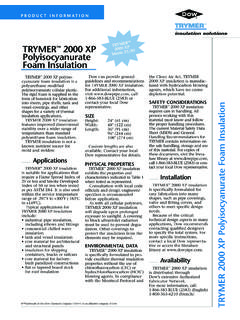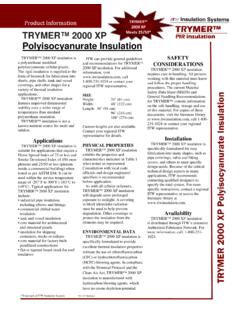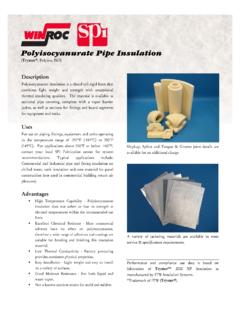Transcription of Thermal insulation materials Polyurethane (PUR) and ...
1 1 Thermal insulation materials Polyurethane (PUR) and polyisocyanurate (PIR) foam Rigid Polyurethane foam (PUR/PIR) is one of the most efficient, high performance insulation materials , enabling very effective energy savings with minimal occupation of space. Better insulation in buildings is a significant contributor towards the implementation of the Kyoto protocol and will also bring additional benefits: energy savings, resulting in lower energy bills both for individuals and for countries. This will help to improve competitiveness of Europe as a whole, protection of the environment: more stringent insulation regulations can cut European CO2 emissions by 5 % (60 % of the present European Kyoto target), a positive impact on job creation, a boost to the European economy.
2 This report describes the properties and manufacture of rigid Polyurethane foam (PUR/PIR), one of the most effective insulants. 2 Introduction Polyurethane enhancing the quality of our lives Whether shoe soles, mattresses, steering wheels or insulation our world today is unthinkable without Polyurethane . In the world of sports or leisure activities, in the home or in the car, polyurethanes have a positive impact on our daily lives. They are needed everywhere. Depending on the formulation and basic chemical mix, the property spectrum of polyurethanes can be precisely determined during manufacture rigid, soft, integral or compact. The result: tailor-made and cost-efficient solutions for (almost) every field of application. Picture 1: Polyurethane a versatile material insulation made to measure When it comes to insulating buildings, rigid Polyurethane foam (PUR/PIR) is the cost-effective insulant for new construction because it has low Thermal conductivity, unmatched by any other conventional product.
3 Further, rigid Polyurethane foam (PUR/PIR) is ideal for renovation when the emphasis is on energy efficiency. Retrofitting insulation in the shells of existing buildings can cut average energy consumption by more than 50% and rigid Polyurethane foam (PUR/PIR) simplifies the installation. Low Thermal conductivity means thinner insulation for any specified insulation level and thinner insulation means it is easier to fit into the building cavity. The insulation performance is exceedingly high even with modest material thicknesses. Finally, good mechanical properties and excellent adhesion to other materials opens up a broad field of applications. With their optimal insulating performance, insulation materials made of rigid Polyurethane foam (PUR/PIR) are very versatile. The products range from insulation boards for roofing, walls, floors and ceilings, to window frame insulation and foam sealants, through to metal-faced sandwich panels for industrial buildings.
4 3 Efficient Thermal insulation to last a lifetime The term rigid Polyurethane foam (PUR/PIR) stands for a family of insulation materials that, in addition to Polyurethane (PUR) also includes polyisocyanurate (PIR) rigid foam. The excellent Thermal insulation properties of closed-cell rigid Polyurethane foam (PUR/PIR) are achieved today mainly with blowing agents such as pentane (hydrocarbon) or CO2. In addition to the low Thermal conductivity, rigid Polyurethane foam (PUR/PIR) is stable and durable. It will function for as long as the building stands and has a useful life beyond 50 years. Thermal insulation with rigid Polyurethane foam (PUR/PIR) conserves resources, saves energy and has no significant emission to the environment. Rigid Polyurethane foam (PUR/PIR) is the right investment for the future as it: offers optimal, long-life insulation with no drawbacks, maintenance or repairs enhances the value of property and the quality of life leads to large energy savings and reduced heating costs is cost-effective and easy to install.
5 4 1. What is rigid Polyurethane foam (PUR/PIR)? Rigid Polyurethane foam (PUR/PIR) is a closed-cell plastic. It is used as factory made Thermal insulation material in the form of insulation boards or block foam, and in combination with various rigid facings as a constructional material or sandwich panel. Polyurethane in-situ foams are manufactured directly on the building site. Picture 2: Rigid Polyurethane foam insulation materials (PUR/PIR) In modest material thicknesses, rigid Polyurethane foam (PUR/PIR) offers optimal Thermal insulation coupled with an exceptional space-utility advantage. For architects and planners, rigid Polyurethane foam (PUR/PIR) allows scope for creative insulation solutions from the cellar and the walls through to the ceilings and the roof.
6 It is ideal in the lightweight, low-energy or zero-energy building approach (Passivhaus). insulation Boards Thanks to their excellent mechanical strength, insulation boards made of rigid Polyurethane foam (PUR/PIR) are highly resistant; they can be combined with other materials and are easy to install on the building site. Metal Faced Sandwich Panels Sandwich panels have a rigid Polyurethane foam (PUR/PIR) core with profiled and in most cases metal facings on both the upper and lower surfaces. Sandwich panels are particularly suited for roofing and wall applications, for the various support structures in halls and industrial buildings, as well as for refrigeration and cold-storage units. The lightweight panels are easy to process and can be installed in all weather conditions. PUR/PIR sandwich panels are to a high degree pre-fabricated, giving them structural and constructional design properties that offer a high level of security, both in the processing stages and in the finished building.
7 Blocks Polyurethane (PUR/PIR) block foam can be cut to shape for the insulating building equipment and industrial installations. 5 In-situ Foams In addition to factory made Polyurethane rigid foams (PUR/PIR), in-situ foams are also used in building. They are produced with state-of-the-art equipment "in situ" on the building site itself. In-situ foams are mainly used for technical insulation applications. The in-situ foam is sprayed onto the desired surface or poured into moulds, producing a seamless structure. 6 2. Technical and physical properties of rigid Polyurethane foam (PUR/PIR) The properties of the insulation materials depend on their structure, the raw materials used and the manufacturing process.
8 In the selection of a suitable Thermal insulation material , the required Thermal properties are of prime importance. For the functionality and safety of the building, other important criteria in the choice of insulation are mechanical strength, resistance to ageing, sound insulation properties, and resistance to moisture and fire. Rigid Polyurethane foam (PUR/PIR) insulation materials display excellent insulation characteristics. They have extremely low Thermal conductivity values and can achieve optimal energy savings. The excellent mechanical strength values and exceptional durability of rigid Polyurethane foam (PUR/PIR) fulfil all the requirements made of insulation materials used in the building industry. Thermal conductivity The most important property of an insulation material is its insulation performance. The yardstick for such insulation performance is low Thermal conductivity or high Thermal resistance.
9 Thermal conductivity and Thermal resistance of insulation materials Thermal conductivity ( ) is a specific material property. It represents the heat flow in watts (W) through a 1 m surface and 1 m thick flat layer of a material when the temperature difference between the two surfaces in the direction of heat flow amounts to 1 Kelvin (K). The unit of measurement for Thermal conductivity ( ) is W/(m K). The Thermal resistance (R) describes the Thermal insulation effect of a constructional layer. It is obtained by dividing the thickness (d) by the design Thermal conductivity value of a building component: R = d/ (in accordance with EN ISO 6946). The unit of Thermal resistance (R) is (m K)/W. In building components comprising several layers, the Thermal resistances of the individual layers are added together. The Thermal transmittance (U) is the heat flow in watts (W) through 1 m of a building component when the temperature difference between the surfaces in the direction of heat flow is 1K.
10 U-value can be calculated from U = 1/R for a given construction, and is generally represented in W/( m K). The Thermal conductivity and Thermal resistance of rigid Polyurethane foam (PUR/PIR) insulation materials are to be determined in accordance with Annex A and Annex C of EN 13165. Thermal conductivity of rigid Polyurethane foam (PUR/PIR) The Thermal conductivity of rigid Polyurethane foam (PUR/PIR) is dependent on: the cell gas used density 7 temperature behaviour in the presence of water and moisture time of measurement Influence of the cell gas The exceptional insulation properties of rigid Polyurethane foam (PUR/PIR) are achieved through the use of blowing agents. The Thermal conductivity of the blowing agent at a reference temperature of 10 C is considerably lower than that of air [( air = 0,024 W/(m K)].)







